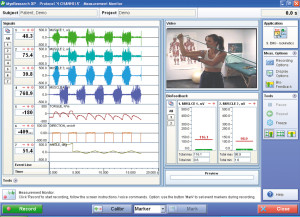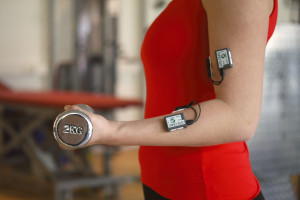sEMG Testing
We offer full wireless full wireless surface
electromyography (SEMG). This is Noraxon’s full 16 sensor
research testing unit which allows for all dysfunction and
performance testing with no filter for raw, research data.
We offer numerous complete reports which are visual
and numerical to give to clients.
As muscles contract, microvolt level electrical signals are created within the muscle that may be measured from the surface of the body. A procedure that measures muscle activity from the skin is referred to as surface electromyography (SEMG)
Researchers and clinicians use SEMG to evaluate the functional status of skeletal muscles and assist in neuromuscular training and rehabilitation. The small electrical current, or signal, which comes from active muscles, is detected by sensors placed on the skin directly above the muscles. The strength and pattern of the signal is displayed onto a computer screen and the data is collected in a software program that is able to run various analyses of the data to create useful reports regarding muscle function.
Because SEMG signals are small, their measurement is susceptible to interference – for example, from electrical equipment, lights or movement of cables that carry signals from the body to the measuring instrument. Evaluations require the subject to perform a full range of movement exercises and interference from movement of lead wires has been a problem.
Lower cost instruments attempt to eliminate artifact by electrode site pre-amplification and by “notching out” or filtering the frequencies at which interference occurs. Unfortunately, these frequencies are also where most SEMG signals are located. Devices that use “notch-filtering” lose essential data. That is why accurate, reliable SEMG measurement was impossible – until Noraxon.
Noraxon’s breakthrough amplifier technology actually distinguishes between SEMG signals and artifact. The result is reliable, repeatable and pure SEMG data that enables professionals to make more precise evaluations of muscle activity and performance. This is the secret behind all Noraxon systems.
Symmetry and Coordination Tests
These various tests allow for the comparison of affected and unaffected sides. Display the EMG and histogram statistics for unilateral, bilateral, multi joint and symmetrical movements. Evaluate the neuromuscular coordination and compare innervation deficiencies between right and left sides.
Average Activation Patterns
Clinicians can assess repeated movement sequences and exercises while creating averaged and time normalized EMG patterns. Analyze the typical innervation structure of movements.
EMG Standard Analysis
The Clinical DTS uses universal protocol for all kinds of EMG setups. View basic amplitude parameters in selected analysis periods. Use standard graphs and histograms designed for general analysis questions.
Feedback Training
Use the bar graph display of signals to provide precise training of dysfunctional muscle groups with both acoustic and optical automatic training assistance.
Gait Analysis
The protocol for this analysis was designed for unilateral and bilateral investigation of EMG gait patterns in functional walking and running activities. View typical activity characteristics and coordination of muscle groups during walking/running while analyzing left/right, pre/post test comparisons. Symmetry, timing and curve characteristics are summarized.
Template Training
Use background templates for biofeedback training. Create EMG/angle/force templates using the healthy side. Use biofeedback and motor learning concepts to confirm the accuracy of performance.
TESTIMONIALS FOR NOAXON EQUIPMENT


